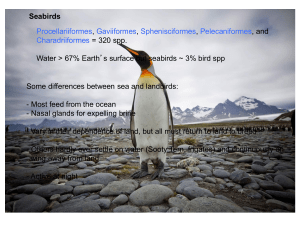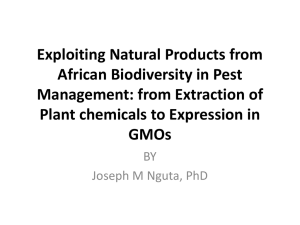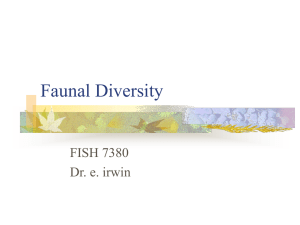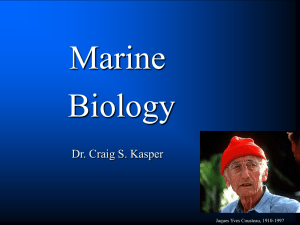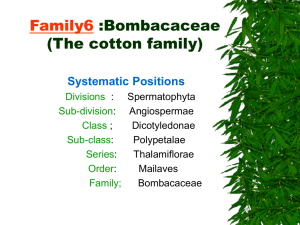Lecture 10 – Apr 3
advertisement
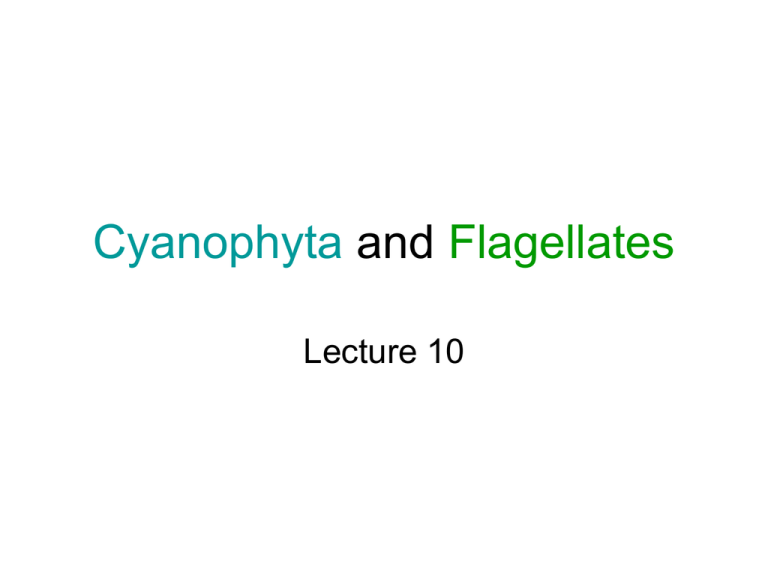
Cyanophyta and Flagellates Lecture 10 OVERVIEW Eubacteria & Protists • Cyanophyta • “Phytoplankton” • Chlorophyta, Phaeophyta, Rhodophyta Vascular Plants (Gymnosperms & Angiosperms) • Seagrasses – Hydrocharitaceae & Potamogetonaceae • Saltmarshes – Poaceae, Juncaceae, etc • Mangroves – Rhizophoraceae, Avicenniaceae • Beach & Dune plants Fan-Shaped Phylogenetic Tree Falkowski & Raven 2007 Algal pigments “Endosymbiosis” Theory • Eukaryotic cells captured and ingested prokaryotic cells and “tamed” them to become organelles (Chloroplasts, Mitochondria – have own DNA). • Chloroplasts from blue-green algal cells, • Mitochondria from bacteria • Flagellum (9+2 microtubules) from motile, saprophytic prokaryote • Rhodophyta ingested a Cyanobacteria (chloroplast with phycobiliproteins) Organelles and endosymbiosis During the 1980s, Lynn Margulis proposed the theory of endosymbiosis to explain the origin of mitochondria and chloroplasts from permanent resident prokaryotes. According to this idea, a larger prokaryote (or perhaps early eukaryote) engulfed or surrounded a smaller prokaryote some 1.5 billion to 700 million years ago. The basic events in endosymbiosis. Image from Purves et al., Life: The Science of Biology, 4th Edition, by Sinauer Associates (www.sinauer.com) and WH Freeman (www.whfreeman.com), used with permission. Falkowski & Raven 2007 “Cyanophyta” • = cyanobacteria or bluegreen algae • Prokaryote Eubacteria– organelles lacking • Unicellular, colonial, filamentous forms • Chl a + Phycocyanin (blue), Phycoerythrin (red), Zeaxanthin • Heterocysts & N-fixation • http://wwwcyanosite.bio.purdue.edu Heterocysts – N fixation Triple layer cell wall: glycolipid and polysaccharide NH4 N2 • Differentiated cell that provides a low O2 environ for Nfixation (nitrogenase) • Oxygen diffusion 100x lower than normal cell • No photosystem II – no p’synth • Higher respiration (uses up O2) • Under genetic control – up regulated under low N, 1 in 10 cells become heterocysts, within 24 hrs, 600-1000 genes involved. http://biology.kenyon.edu/Microbial_Biorealm/bacteria/anabaena/anabaena.htm http://www2.hawaii.edu/~scallaha/SMCsite/Research.html Heterocysts – N fixation Triple layer cell wall: glycolipid and polysaccharide NH4 N2 • Differentiated cell that provides a low O2 environ for N-fixation (nitrogenase) • Oxygen diffusion 100x lower than normal cell • No photosystem II – no p’synth • Higher respiration (uses up O2) • Under genetic control – up regulated under low N, 1 in 10 cells become heterocysts, within 24 hrs, 600-1000 genes involved. Cyanophyta • Stromatolites – Bermuda, Shark Bay • 3.5 Bio – 600 Mio • O2 production – red bands (FeOx) • Warm, low energy, low grazing. • http://stromatolites .info/ Cyanophyta • Stromatolites – Bermuda, Shark Bay • 3.5 Bio – 600 Mio • O2 production – red bands (FeOx) • Warm, low energy, low grazing. • http://stromatolites .info/ Cyanophyta • Stromatolites – Bermuda, Shark Bay • Lyngbya • Oscillatoria • Scytonema Cyanophyta • Stromatolites – Bermuda, Shark Bay • Lyngbya • Oscillatoria • Nostoc • Trichodesmium Div Cyanophyta taxonomy • Single class: Cyanophyceae. • No flagellae, no organelles • No sexual reproduction, use transformation and conjugation (bacterial recombinant process) • Mostly freshwater, some marine and terrestrial habitats (including glaciers, hot springs, etc.) • 150 genera, 2000 spp • Prefer warm, quiescent water, often higher salinities. • Important members of the picoplankton (0.2-2um) • 5 Orders: Chroococcales, Pleurocapsales, Oscillatoriales, Nostocales, Stigonematales “Thallus” organization • • • • Unicells – Chroococales Colonial – Pleurocapsales Filamentous – Oscillatoriales, Nostocales Simple parenchymatous – Stigonematales • Two taxonomic systems: • Geitler (1932) based on morphology • Stanier (1977) based on axenic clonal culture (bacteriological techniques) http://tolweb.org/Cyanobacteria/2290 http://www-cyanosite.bio.purdue.edu/images/images.html Or. Chroococales Chroococcus Microcystis Or. Pleurocapsales Cyanocystis Pleurocapsa Black bands on seashore rocks Or. Oscillatoriales - Stromatolites Lyngbya Trichodesmium Lyngbya Oscillatoria Microcoleus Heterocysts Or. Nostocales Nostoc Anabaena Autofluorescence image Or. Stigonematales Fisherella Microbial Mats http://www.marine.unc.edu/Paerllab/sansalmo/index.htm Cyanophyta summary • Prokayotic Eubacteria • Simplest photosynthesizers – stromatolites and atmospheric oxygen • N-fixation in heterocysts • Oscillatoriales most important marine order. • Can form blooms: toxins, anoxia • Microbial Mats important area of research “Phytoplankton” • • • • Passive floating Photic Zone (0-100m depth = 0.1% PAR) Diurnal Vertical Migration (DVM) Sampling – Plankton Net (mesh = 4076mm mesh size, silk or nylon). • 30 yr N. Atl dataset - Continuous Plankton Records (CPR): Plankton Atlas of the North Atlantic Ocean (1958–1999). MEPS Suppl. 3, 2004. “Phytoplankton” • Size: net- (40-80+mm), nanno- (2-20mm), pico- (0.2-2mm), ultra- (<0.2mm) • Filtering, microscopy cell counts. • 47 Pigments: chls + accessory pigments • Analysis by HPLC (High Performance Liquid Chromatography) • Pigments have potential use in Remote Sensing of presence/concentration “Phytoplankton” • Unicells • Filamentous • Colonies – chains, or spheres Flagellates • Mixed bag taxonomically, includes “picoplankton (<2mm)” • “naked” – don’t preserve well, need to be studied while living • Size <1mm – 1mm • >1x109 cells / Liter in blooms! • Ubiquitous, poorly studied to date Flagellates Euglena Flagellum • 2 central + 9 axial microtubules • Single or paired • Anterior, posterior flagellum • Smooth or “hairy” • Basal body = anchoring structure Flagellum • 2 central + 9 axial microtubules • Single or paired • Anterior, posterior flagellum • Smooth or “hairy” • Basal body = anchoring structure Flagellates • Division Chlorophyta • Class: – Euglenophyceae – Prasinophyceae – Chlorophyceae Chlamydomonas • Chl a + b • Division Chromophyta – Cryptophyceae • Division Heterokontophyta – Dinophyceae (naked Dinoflagellates) – Raphidophyceae – Chrysophyceae – Xanthophyceae – Dictyochophyceae – Prymnesiophyceae • Chl a + accessory pigments (carotenoids) Class Euglenophyceae • • • • • • Can also be placed in Div. Euglenophyta Chl a+b Eyespot Mainly FW, some marine 6 orders, 40 genera, 800 spp Heterotrophy important Class Euglenophyceae • • • • • • Single Class – Euglenophyceae Chl a+b Eyespot Mainly FW, some marine 6 orders, 40 genera, 800 spp Heterotrophy important Class Prasinophyceae • 4 Orders, 16 genera, 180 spp • Cells with 1-8 flagellae • Bathycoccus - picoplankton (0.5-2um), N. Atlantic • Pterosperma - large (100-800um) cystlike stages = phycomata. Fossil cysts from 1.2 Bya. Class Prasinophyceae • 4 Orders, 16 genera, 180 spp • Cells with 1-8 flagellae • Bathycoccus - picoplankton (0.5-2nm), N. Atlantic • Pterosperma - large (100-800nm) cystlike stages = phycomata. Fossil cysts from 1.2 Bya. Class Chlorophyceae • 4 orders, 355 genera, 2650 spp – only v few marine. • Or Volvocales – unicell & colonial, Chlamydomonas, Volvox • Or Chlorococcales – unicell -> siphononous, Chlorella (1-2um), endosymbiont in tropical foramifera, Scenedesmus (brackish, eutrophic) • Or Chaetophorales – no marine spp • Or Oedogoniales – filamentous, Oedogonium 400spp Class Chlorophyceae • 4 orders, 355 genera, 2650 spp – only v few marine. • Or Volvocales – unicell & colonial, Chlamydomonas, Volvox • Or Chlorococcales – unicell -> siphononous, Chlorella (1-2um), endosymbiont in tropical foramifera, Scenedesmus (brackish, eutrophic) • Or Chaetophorales – no marine spp • Or Oedogoniales – filamentous, Oedogonium 400spp Flagellates • Division Chlorophyta • Class: – Euglenophyceae – Prasinophyceae – Chlorophyceae Chlamydomonas • Chl a + b • Division Chromophyta – Cryptophyceae • Division Heterokontophyta – Dinophyceae (naked Dinoflagellates) – Raphidophyceae – Chrysophyceae – Xanthophyceae – Dictyochophyceae – Prymnesiophyceae • Chl a + accessory pigments (carotenoids) Class Cryptophyceae • 12 genera, 200 spp, ½ marine • Biflagellate, ventral gullet with trichocysts, accessory pigments (phycobilins, xanthophylls, carotenes) • Dominate nannoplankton (2-20um) in North Sea spring blooms – Cryptomonas • Massive blooms of Mesodinium in upwelling zones (Peru, Baja California) Class Cryptophyceae • Class Cryptophyceae – 12 genera, 200 spp, ½ marine • Biflagellate, ventral gullet with trichocysts, Cryptomonas accessory pigments (phycobilins, xanthophylls, carotenes) • Dominate nannoplankton (2-20um) in North Sea spring blooms – Cryptomonas • Massive blooms of Mesodinium in upwelling zones (Peru, Baja California) Class Raphidophyceae • Heterokont = long tinsel flagellum anterior, short smooth flag posterior • 1. Class Raphidophyceae – 9 genera. • Unicell flagellates, 2 flagellae, cells 50100um, curved dorsal side, flattened ventral side with flagellar groove. • FW and marine – form HABs in Japan, DE • Chattonella, Fibrocapsa Div Heterokontophyta • Heterokont = long tinsel flagellum anterior, short smooth flag posterior • Class Raphidophyceae – 9 genera. • Unicell flagellates, 2 flagellae, cells 50100um, curved dorsal side, flattened ventral side with flagellar groove. • FW and marine – form HABs in Japan, DE • Chattonella, Fibrocapsa Chattonella Fibrocapsa Class Chrysophyceae • Unicell, amoeboid, coccoid, filamentous forms • 2. Class Chrysophyceae, 3 orders, 200 genera, 1000 spp, v. few marine. Includes Pelagoccocus (picoplankt) and Sarcinochrysis (estuarine) • 3. Class Xanthophyceae, 7 orders, 100 genera, 600 spp, few marine. Includes the mat forming Vaucheria (50 spp) – siphonous construction Class Xanthophyceae • Unicell, amoeboid, coccoid, filamentous forms • Class Chrysophyceae, 3 orders, 200 genera, 1000 spp, v. few marine. Includes Pelagoccocus (picoplankt) and Sarcinochrysis (estuarine) • Class Xanthophyceae, 7 orders, 100 genera, 600 spp, few marine. Includes the mat forming Vaucheria (50 spp) – siphonous construction 10 um Pelagococcus Vaucheria (from GCRL) Class Dictychophyceae • 4. Class Dictyochophyceae – 2 spp extant • Single flagellum with mastigonemes (hairs). Siliceous skeleton (fossilizes well), 120 Mya evolved (silicoflagellates) • More prevalent cooler waters. Used to estimate historic SST. • Dictyocha fibula and D. speculum Div Heterokontophyta • Class Dictyochophyceae – 2 spp extant • Single flagellum with mastigonemes (hairs). Siliceous skeleton (fossilizes well), 120 Mya evolved (silicoflagellates) • More prevalent cooler waters. Used to estimate historic SST. • Dictyocha fibula and D. speculum Dictyocha Summary • Flagellates part of phytoplankton – often picoplankton, poorly studied, don’t preserve well, very small, hard to ID • 2 groups – green pigments (Div Chlorophyta), brown pigments (Div Chromophyta / Heterokontophyta) • Some groups prone to blooms and HABs

